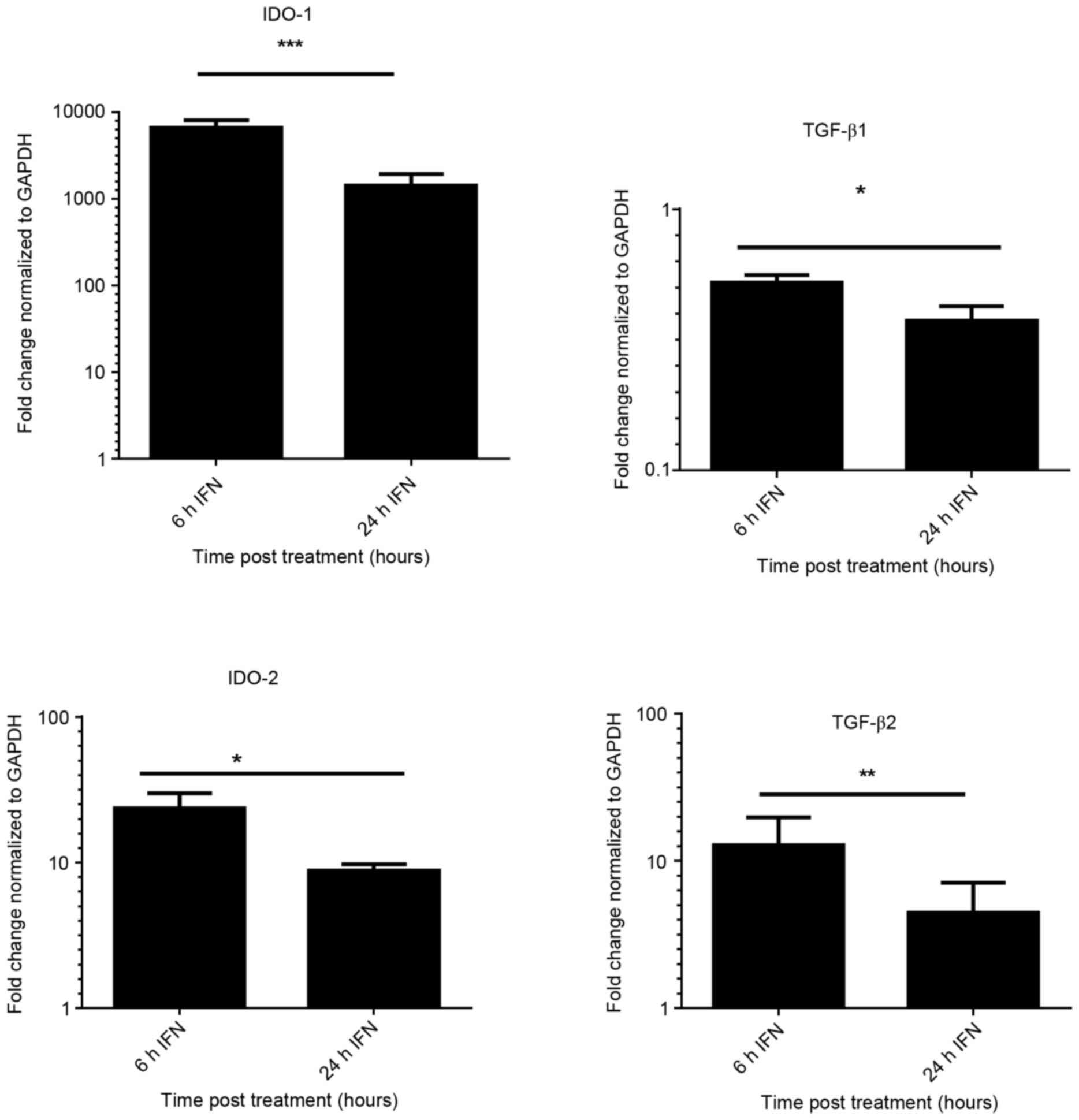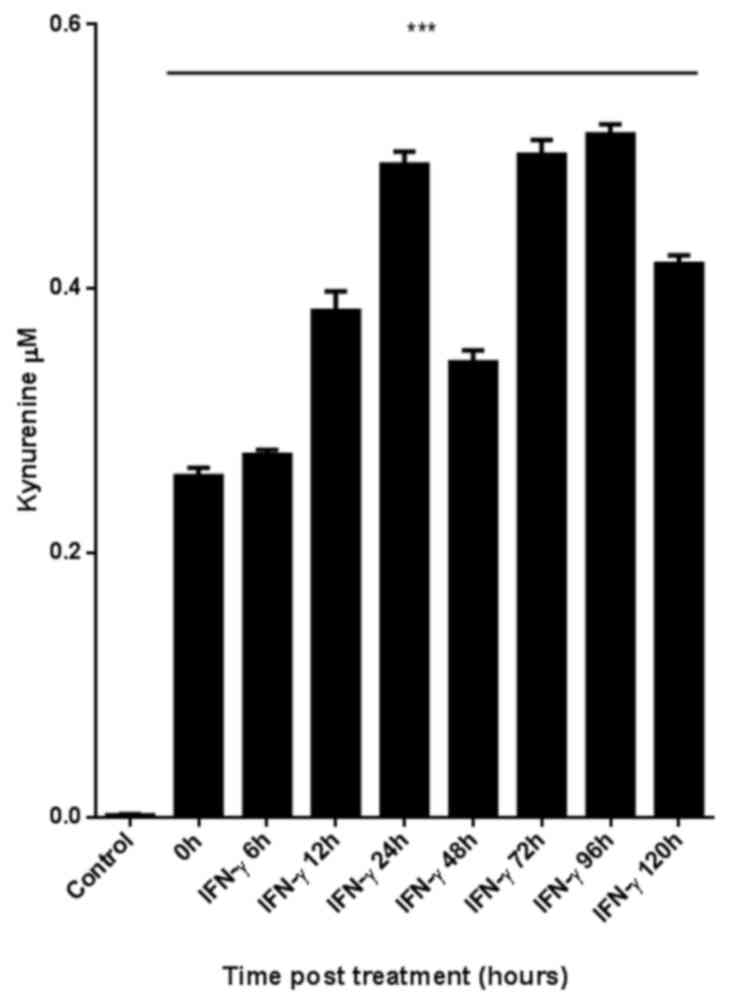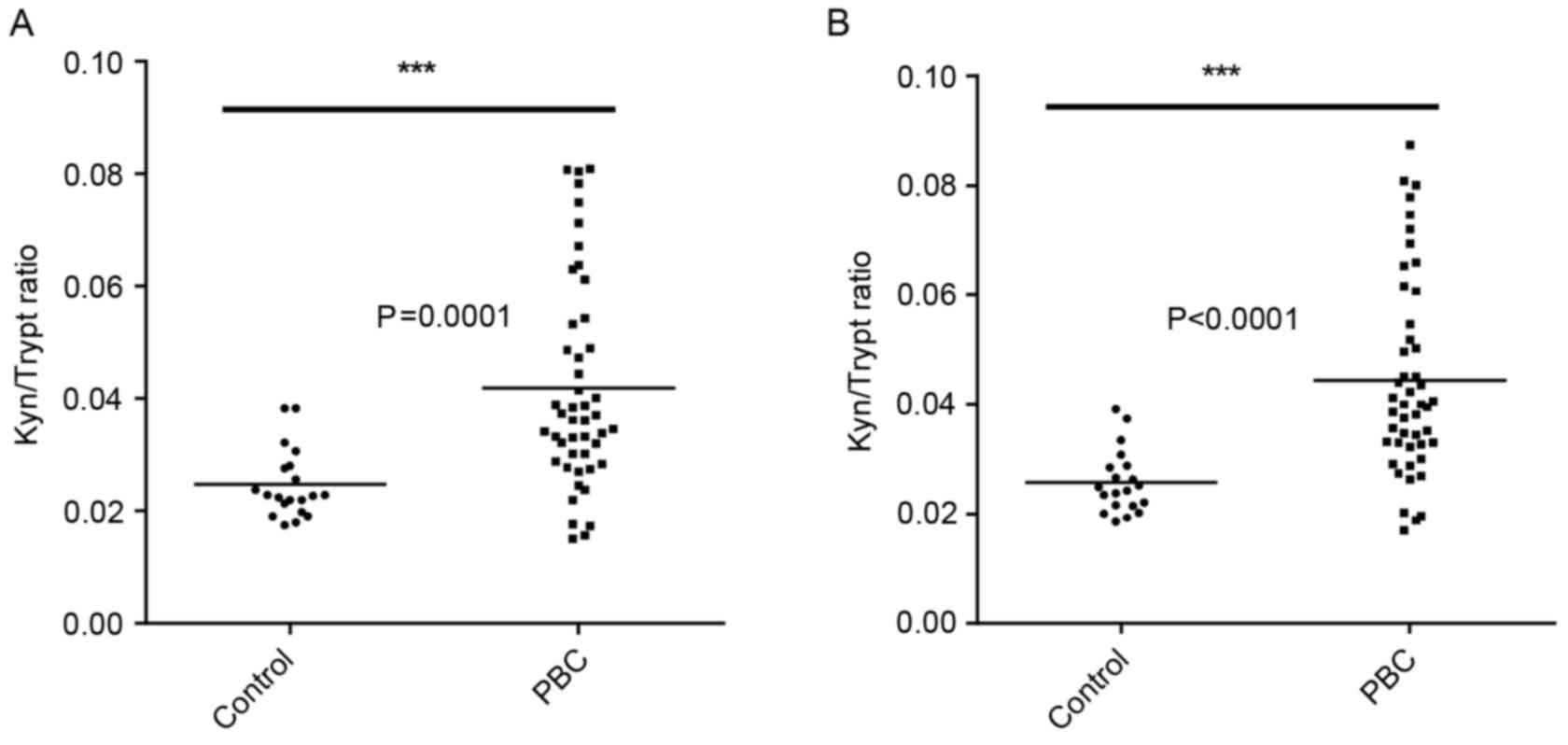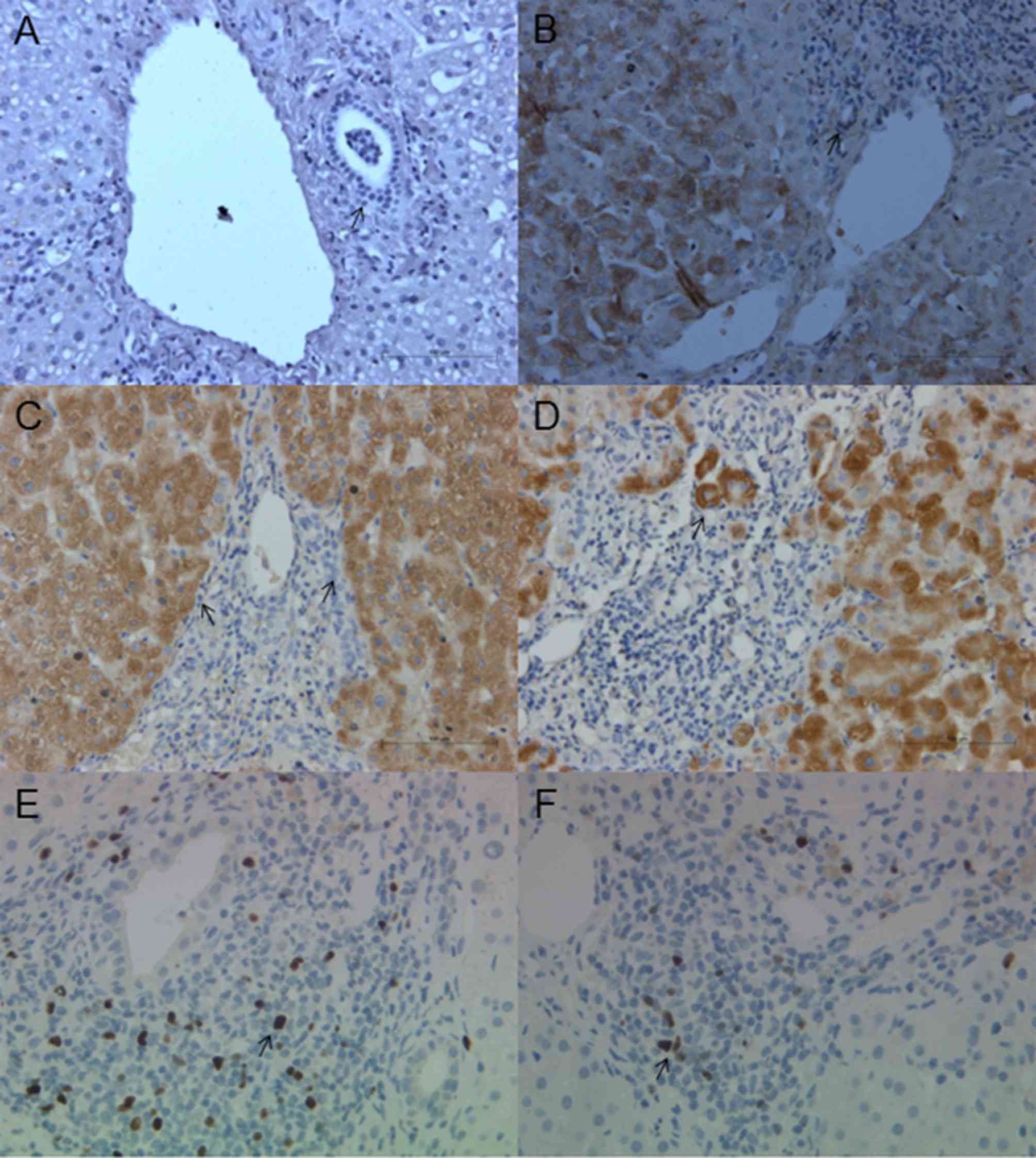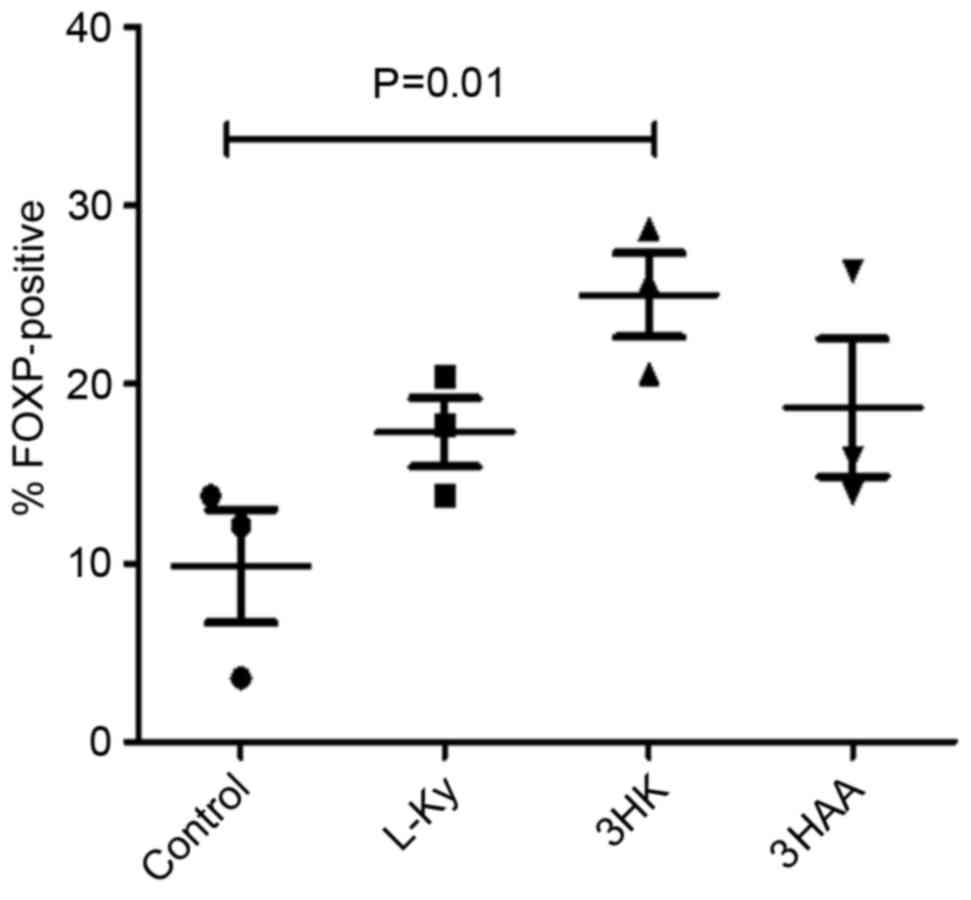|
1
|
Mellor AL and Munn DH: IDO expression by
dendritic cells: Tolerance and tryptophan catabolism. Nat Rev
Immunol. 4:762–774. 2004. View
Article : Google Scholar : PubMed/NCBI
|
|
2
|
Uyttenhove C, Pilotte L, Théate I,
Stroobant V, Colau D, Parmentier N, Boon T and Van den Eynde BJ:
Evidence for a tumoral immune resistance mechanism based on
tryptophan degradation by indoleamine 2,3-dioxygenase. Nat Med.
9:1269–1274. 2003. View
Article : Google Scholar : PubMed/NCBI
|
|
3
|
Curti A, Aluigi M, Pandolfi S, Ferri E,
Isidori A, Salvestrini V, Durelli I, Horenstein AL, Fiore F,
Massaia M, et al: Acute myeloid leukemia cells constitutively
express the immunoregulatory enzyme indoleamine 2,3-dioxygenase.
Leukemia. 21:353–355. 2007. View Article : Google Scholar : PubMed/NCBI
|
|
4
|
Däubener W and MacKenzie CR: IFN-gamma
activated indoleamine 2,3-dioxygenase activity in human cells is an
antiparasitic and an antibacterial effector mechanism. Adv Exp Med
Biol. 467:517–524. 1999. View Article : Google Scholar : PubMed/NCBI
|
|
5
|
Ball HJ, Sanchez-Perez A, Weiser S, Austin
CJ, Astelbauer F, Miu J, McQuillan JA, Stocker R, Jermiin LS and
Hunt NH: Characterization of an indoleamine 2,3-dioxygenase-like
protein found in humans and mice. Gene. 396:203–213. 2007.
View Article : Google Scholar : PubMed/NCBI
|
|
6
|
Metz R, Duhadaway JB, Kamasani U,
Laury-Kleintop L, Muller AJ and Prendergast GC: Novel tryptophan
catabolic enzyme IDO2 is the preferred biochemical target of the
antitumor indoleamine 2,3-dioxygenase inhibitory compound
D-1-methyl-tryptophan. Cancer Res. 67:7082–7087. 2007. View Article : Google Scholar : PubMed/NCBI
|
|
7
|
Lob S, Konigsrainer A, Schafer R,
Rammensee HG, Opelz G and Terness P: Levo- but not dextro-1-methyl
tryptophan abrogates the IDO activity of human dendritic cells.
Blood. 111:2152–2154. 2008. View Article : Google Scholar : PubMed/NCBI
|
|
8
|
Oertelt-Prigione S, Mao TK, Selmi C,
Tsuneyama K, Ansari AA, Coppel RL, Invernizzi P, Podda M and
Gershwin ME: Impaired indoleamine 2,3-dioxygenase production
contributes to the development of autoimmunity in primary biliary
cirrhosis. Autoimmunity. 41:92–99. 2008. View Article : Google Scholar : PubMed/NCBI
|
|
9
|
Lan RY, Cheng C, Lian ZX, Tsuneyama K,
Yang GX, Moritoki Y, Chuang YH, Nakamura T, Saito S, Shimoda S, et
al: Liver-targeted and peripheral blood alterations of regulatory T
cells in primary biliary cirrhosis. Hepatology. 43:729–737. 2006.
View Article : Google Scholar : PubMed/NCBI
|
|
10
|
Shimoda S, Van de Water J, Ansari A,
Nakamura M, Ishibashi H, Coppel RL, Lake J, Keeffe EB, Roche TE and
Gershwin ME: Identification and precursor frequency analysis of a
common T cell epitope motif in mitochondrial autoantigens in
primary biliary cirrhosis. J Clin Invest. 102:1831–1840. 1998.
View Article : Google Scholar : PubMed/NCBI
|
|
11
|
Kita H, Matsumura S, He XS, Ansari AA,
Lian ZX, Van de Water J, Coppel RL, Kaplan MM and Gershwin ME:
Quantitative and functional analysis of PDC-E2-specific
autoreactive cytotoxic T lymphocytes in primary biliary cirrhosis.
J Clin Invest. 109:1231–1240. 2002. View Article : Google Scholar : PubMed/NCBI
|
|
12
|
Grohmann U, Fallarino F and Puccetti P:
Tolerance, DCs and tryptophan: Much ado about IDO. Trends Immunol.
24:242–248. 2003. View Article : Google Scholar : PubMed/NCBI
|
|
13
|
Munn DH, Sharma MD and Mellor AL: Ligation
of B7-1/B7-2 by human CD4+ T cells triggers indoleamine
2,3-dioxygenase activity in dendritic cells. J Immunol.
172:4100–4110. 2004. View Article : Google Scholar : PubMed/NCBI
|
|
14
|
Munn DH, Sharma MD, Baban B, Harding HP,
Zhang Y, Ron D and Mellor AL: GCN2 kinase in T cells mediates
proliferative arrest and anergy induction in response to
indoleamine 2,3-dioxygenase. Immunity. 22:633–642. 2005. View Article : Google Scholar : PubMed/NCBI
|
|
15
|
Mezrich JD, Fechner JH, Zhang X, Johnson
BP, Burlingham WJ and Bradfield CA: An interaction between
kynurenine and the aryl hydrocarbon receptor can generate
regulatory T cells. J Immunol. 185:3190–3198. 2010. View Article : Google Scholar : PubMed/NCBI
|
|
16
|
Terness P, Bauer TM, Röse L, Dufter C,
Watzlik A, Simon H and Opelz G: Inhibition of allogeneic T cell
proliferation by indoleamine 2,3-dioxygenase-expressing dendritic
cells: Mediation of suppression by tryptophan metabolites. J Exp
Med. 196:447–457. 2002. View Article : Google Scholar : PubMed/NCBI
|
|
17
|
Frumento G, Rotondo R, Tonetti M, Damonte
G, Benatti U and Ferrara GB: Tryptophan-derived catabolites are
responsible for inhibition of T and natural killer cell
proliferation induced by indoleamine 2,3-dioxygenase. J Exp Med.
196:459–468. 2002. View Article : Google Scholar : PubMed/NCBI
|
|
18
|
Fallarino F, Grohmann U, Vacca C, Bianchi
R, Orabona C, Spreca A, Fioretti M and Puccetti P: T cell apoptosis
by tryptophan catabolism. Cell Death Differ. 9:1069–1077. 2002.
View Article : Google Scholar : PubMed/NCBI
|
|
19
|
Fallarino F, Grohmann U, Vacca C, Orabona
C, Spreca A, Fioretti MC and Puccetti P: T cell apoptosis by
kynurenines. Adv Exp Med Biol. 527:183–190. 2003. View Article : Google Scholar : PubMed/NCBI
|
|
20
|
Seman M, Adriouch S, Scheuplein F, Krebs
C, Freese D, Glowacki G, Deterre P, Haag F and Koch-Nolte F:
NAD-induced T cell death: ADP-ribosylation of cell surface proteins
by ART2 activates the cytolytic P2X7 purinoceptor. Immunity.
19:571–582. 2003. View Article : Google Scholar : PubMed/NCBI
|
|
21
|
Fallarino F, Grohmann U, You S, McGrath
BC, Cavener DR, Vacca C, Orabona C, Bianchi R, Belladonna ML, Volpi
C, et al: The combined effects of tryptophan starvation and
tryptophan catabolites down-regulate T cell receptor zeta-chain and
induce a regulatory phenotype in naive T cells. J Immunol.
176:6752–6761. 2006. View Article : Google Scholar : PubMed/NCBI
|
|
22
|
Rubtsov YP and Rudensky AY: TGFbeta
signalling in control of T-cell-mediated self-reactivity. Nat Rev
Immunol. 7:443–453. 2007. View Article : Google Scholar : PubMed/NCBI
|
|
23
|
Belladonna ML, Volpi C, Bianchi R, Vacca
C, Orabona C, Pallotta MT, Boon L, Gizzi S, Fioretti MC, Grohmann U
and Puccetti P: Cutting edge: Autocrine TGF-beta sustains default
tolerogenesis by IDO-competent dendritic cells. J Immunol.
181:5194–5198. 2008. View Article : Google Scholar : PubMed/NCBI
|
|
24
|
Yuan W, Collado-Hidalgo A, Yufit T, Taylor
M and Varga J: Modulation of cellular tryptophan metabolism in
human fibroblasts by transforming growth factor-beta: Selective
inhibition of indoleamine 2,3-dioxygenase and tryptophanyl-tRNA
synthetase gene expression. J Cell Physiol. 177:174–186. 1998.
View Article : Google Scholar : PubMed/NCBI
|
|
25
|
MacKenzie CR, González RG, Kniep E, Roch S
and Däubener W: Cytokine mediated regulation of
interferon-gamma-induced IDO activation. Adv Exp Med Biol.
467:533–539. 1999. View Article : Google Scholar : PubMed/NCBI
|
|
26
|
Thomas SR, Mohr D and Stocker R: Nitric
oxide inhibits indoleamine 2,3-dioxygenase activity in
interferon-gamma primed mononuclear phagocytes. J Biol Chem.
269:14457–14464. 1994.PubMed/NCBI
|
|
27
|
Martinez OM, Villanueva JC, Gershwin ME
and Krams SM: Cytokine patterns and cytotoxic mediators in primary
biliary cirrhosis. Hepatology. 21:113–119. 1995. View Article : Google Scholar : PubMed/NCBI
|
|
28
|
Neuman M, Angulo P, Malkiewicz I,
Jorgensen R, Shear N, Dickson ER, Haber J, Katz G and Lindor K:
Tumor necrosis factor-alpha and transforming growth factor-beta
reflect severity of liver damage in primary biliary cirrhosis. J
Gastroenterol Hepatol. 17:196–202. 2002. View Article : Google Scholar : PubMed/NCBI
|
|
29
|
Grubman SA, Perrone RD, Lee DW, Murray SL,
Rogers LC, Wolkoff LI, Mulberg AE, Cherington V and Jefferson DM:
Regulation of intracellular pH by immortalized human intrahepatic
biliary epithelial cell lines. Am J Physiol. 266:G1060–G1070.
1994.PubMed/NCBI
|
|
30
|
Brain JG, Robertson H, Thompson E,
Humphreys EH, Gardner A, Booth TA, Jones DE, Afford SC, von
Zglinicki T, Burt AD and Kirby JA: Biliary epithelial senescence
and plasticity in acute cellular rejection. Am J Transplant.
13:1688–1702. 2013. View Article : Google Scholar : PubMed/NCBI
|
|
31
|
Chomczynski P and Sacchi N: Single-step
method of RNA isolation by acid guanidinium
thiocyanate-phenol-chloroform extraction. Anal Biochem.
162:156–159. 1987. View Article : Google Scholar : PubMed/NCBI
|
|
32
|
Livak KJ and Schmittgen TD: Analysis of
relative gene expression data using real-time quantitative PCR and
the 2(-Delta Delta C(T)) method. Methods. 25:402–408. 2001.
View Article : Google Scholar : PubMed/NCBI
|
|
33
|
Takikawa O, Kuroiwa T, Yamazaki F and Kido
R: Mechanism of interferon-gamma action. Characterization of
indoleamine 2,3-dioxygenase in cultured human cells induced by
interferon-gamma and evaluation of the enzyme-mediated tryptophan
degradation in its anticellular activity. J Biol Chem.
263:2041–2048. 1988.PubMed/NCBI
|
|
34
|
Laich A, Neurauter G, Widner B and Fuchs
D: More rapid method for simultaneous measurement of tryptophan and
kynurenine by HPLC. Clin Chem. 48:579–581. 2002.PubMed/NCBI
|
|
35
|
Hwu P, Du MX, Lapointe R, Do M, Taylor MW
and Young HA: Indoleamine 2,3-dioxygenase production by human
dendritic cells results in the inhibition of T cell proliferation.
J Immunol. 164:3596–3599. 2000. View Article : Google Scholar : PubMed/NCBI
|
|
36
|
Billiau A and Matthys P: Interferon-gamma:
A historical perspective. Cytokine Growth Factor Rev. 20:97–113.
2009. View Article : Google Scholar : PubMed/NCBI
|
|
37
|
Sakash JB, Byrne GI, Lichtman A and Libby
P: Cytokines induce indoleamine 2,3-dioxygenase expression in human
atheroma-associated cells: Implications for persistent
Chlamydophila pneumoniae infection. Infect Immun. 70:3959–3961.
2002. View Article : Google Scholar : PubMed/NCBI
|
|
38
|
Munn DH, Sharma MD, Lee JR, Jhaver KG,
Johnson TS, Keskin DB, Marshall B, Chandler P, Antonia SJ and
Burgess R: Potential regulatory function of human dendritic cells
expressing indoleamine 2,3-dioxygenase. Science. 297:1867–1870.
2002. View Article : Google Scholar : PubMed/NCBI
|
|
39
|
Knox WE and Mehler AH: The conversion of
tryptophan to kynurenine in liver I. The coupled tryptophan
peroxidase-oxidase system forming formylkynurenine. J Biol Chem.
187:419–430. 1950.PubMed/NCBI
|
|
40
|
Viñals F and Pouysségur J: Transforming
growth factor beta1 (TGF-beta1) promotes endothelial cell survival
during in vitro angiogenesis via an autocrine mechanism implicating
TGF-alpha signaling. Mol Cell Biol. 21:7218–7230. 2001. View Article : Google Scholar : PubMed/NCBI
|
|
41
|
Shirey KA, Jung JY, Maeder GS and Carlin
JM: Upregulation of IFN-gamma receptor expression by
proinflammatory cytokines influences IDO activation in epithelial
cells. J Interferon Cytokine Res. 26:53–62. 2006. View Article : Google Scholar : PubMed/NCBI
|
|
42
|
Zegarra-Moran O, Folli C, Manzari B,
Ravazzolo R, Varesio L and Galietta LJ: Double mechanism for apical
tryptophan depletion in polarized human bronchial epithelium. J
Immunol. 173:542–549. 2004. View Article : Google Scholar : PubMed/NCBI
|
|
43
|
Schröcksnadel K, Wirleitner B, Winkler C
and Fuchs D: Monitoring tryptophan metabolism in chronic immune
activation. Clin Chim Acta. 364:82–90. 2006. View Article : Google Scholar : PubMed/NCBI
|
|
44
|
Platten M, Ho PP, Youssef S, Fontoura P,
Garren H, Hur EM, Gupta R, Lee LY, Kidd BA, Robinson WH, et al:
Treatment of autoimmune neuroinflammation with a synthetic
tryptophan metabolite. Science. 310:850–855. 2005. View Article : Google Scholar : PubMed/NCBI
|















